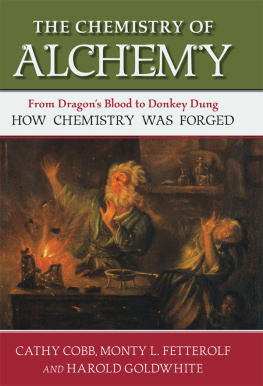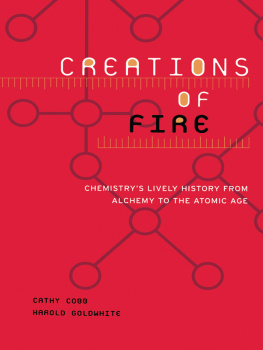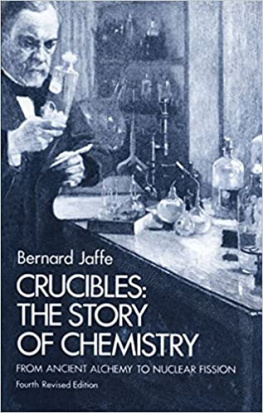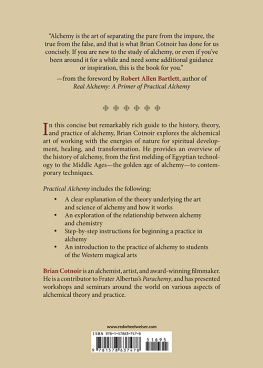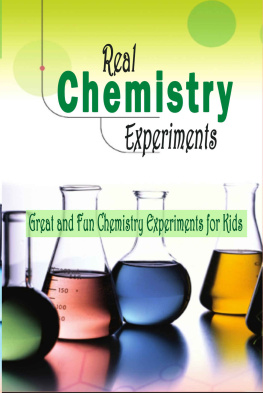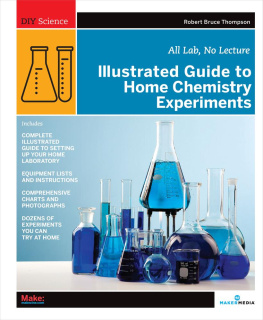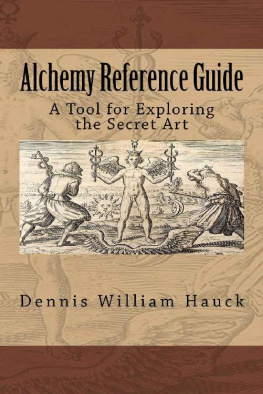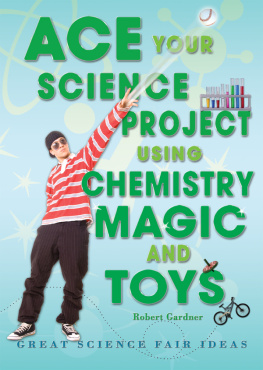

CATHY COBB is the author of Magick, Mayhem, and Mavericks and the coauthor of The Joy of Chemistry (with Monty L. Fetterolf), Crime Scene Chemistry for the Armchair Sleuth (with Monty L. Fetterolf and Jack G. Goldsmith), and Creations of Fire (with Harold Goldwhite). She is an instructor of chemistry, physics, and calculus at Mead Hall School in Aiken, South Carolina.
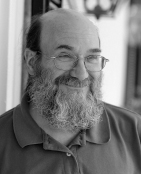
MONTY L. FETTEROLF is the coauthor of The Joy of Chemistry (with Cathy Cobb) and Crime Scene Chemistry for the Armchair Sleuth (with Cathy Cobb and Jack G. Goldsmith). He is a professor of chemistry and the department chair of the Department of Chemistry and Physics at the University of South Carolina at Aiken.
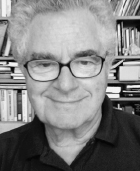
HAROLD GOLDWHITE, emeritus professor of chemistry at California State University, Los Angeles, is the author of eight textbooks on chemistry and the coauthor of Creations of Fire (with Cathy Cobb).
Cobb and Fetterolf photos Scott Webster, Webster Photography.
Goldwhite photo by Harold Goldwhite.

James Bohning and Marjorie Gapp, of the Chemical Heritage Foundation; the staff of the John F. Kennedy Library, California State University, Los Angeles; and Elton-John Torres of the Rare Book and Manuscript Library, University of Pennsylvania, for assistance with illustrations.
H. G.
Thanks: To Erina Hoshi, the student who taught us so much. Without your inspiration, instinct, patience, and persistence, we would still be working on demos in the lab. You are a wonderful chemist and friend. Thank you.
Acknowledgments: Brigitte Smith and the library staff at the University of South Carolina at Aiken for helping us locate the dusty old alchemical books we needed; the Department of Chemistry and Physics at the University of South Carolina at Aiken for their support and the use of laboratory facilities; Kathleen McCallister of Columbia Rare Books and Special Collections of the University of South Carolina for locating critical materials; and Mead Hall Episcopal School of Aiken South Carolina for encouragement, office space, and an excellent daily salad bar for lunch.
C. C. and M. L. F.
Thanks to Dr. and Mrs. Clarence Cobb for (once again!) reading every word of a tedious first draft, and to Judy Dailey, the most supportive sister in the world, for advice and guidance, past, present, and future.
Thanks to the people who have chosen to befriend me, though I don't know why: Daphne Harris (friend and sister), Joanne Morton, Linda Muse, Susan Varallo, and Francesca Pataro (who has walked with me many, many miles). Many thanks to Linda Muse, friend and creator of the wonderful illustrations that grace these pages, and thanks to Dr. Gary Patterson for his interest in characters in chemistry, including me.
Special thanks also to Tara Bostwick of Aiken Educational Services for generous access to stables and manure piles, to Porky Bradberry of Porky Bradberry's Jewelry for donating gold samples to dissolve, and to Alan Harding for introducing me to Lou Tice, who wrote a couple of books about reaching a goal.
C. C.

Just asthey sell all kinds of fishso that everyone can eatso it's necessary to have all sorts of writers[for] everyone to have some food for thought.
Leonardo Fioravanti, ca. 1580
This book was not written for experts. We are not historians, and this is not a history. Although we develop our topic quasi-chronologically, we do not cover all alchemists. Like midnight revelers looking in the lamplight for their keys, we stayed with the alchemists with reproducible alchemical practices and, quite frankly, interesting personalities. We relied heavily on previous scholarship and recommend excellent authors in our bibliography for those desiring a fuller historical development.
In addition, in this limited space, we could not be comprehensive. Alchemy was (is?) a complex, shape-shifting phenomenon once practiced in cultures across the globe, but we confined ourselves to the western-European alchemical tradition, and mostly Christian at that, though during the time period we cover (essentially western-European Middle Ages to the early modern age) otherJudeo, Islamic, Asian, Africanalchemical customs flourished.
On the other hand, we are chemistsbut this book wasn't written for chemical experts, either. It was written for non-chemists (or non-alchemists, if you will) whose high school chemistry is a fond memory. The technical descriptions are basic and brief and rely on fundamental chemical principles described in straightforward explications of chemistry, such as our previous work, The Joy of Chemistry, and those listed in our bibliography.
We limited our materials and methods. The highest temperature we achieve is the HI setting of a normal kitchen burner, and we didn't use body fluids, even when a recipe called for them (with one notable exception). We won't be exacting in amounts and measures (but, for the most part, neither were they), and we exclude mercury, lead, and arsenic from our recipes, cowards that we are.
Moreover, in perhaps the most controversial move, we limited our alchemists to believers in metallic transmutation and seekers of the secret in ancient books. We did not dwell on the parallel evolution of practical chemical artisans, although the conjoined pursuits of alchemy and chemical craft cannot be realistically severed. Finally, we dealt only peripherally with the philosophy of alchemy and chose instead to focus on the practice. In fact, we started this book with less interest in philosophy than in psychology: we wanted to know what made the alchemists tick.
We wanted to know what made them think they could make gold and what kept them at their kettles, failure after failure. What made them risk life and limb, prostitute their intellect, and sell their possessions to buy one more day at the fires? We knew understanding would not come from words or paintings but had to be experienced firsthand, which led to the development of the demonstrations, reenactments of alchemical proceduresand which also led immediately to substantial problems.
The first problem was, of course, safety. Even if the old alchemists knew all the dangers, which often they didn't, these adventurers would not have respected any sort of safety standard (they were, after all, willing to risk the gallows), so sometimes safer substitutes had to be foundthough not as often as might be expectedbecause we found (after many, many trials) that sometimes some of the more dangerous ingredients, such as mercury, were added gratuitously. And though we were able to demonstrate to ourselves how the necessary materials could be extracted from natural sources (the body fluids we alluded to), we found this often entailed a discouraging amount time, effort, and odor, even for seasoned chemists; so, although we will describe some adventures in this department briefly, we mainly used available commercial sources in our demonstrations. As a result, we lost some authenticity, but we gained enormous respect for the alchemists.
Next page
